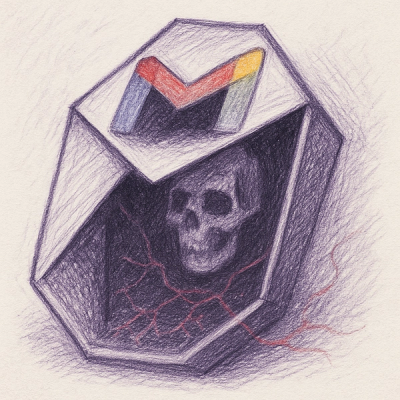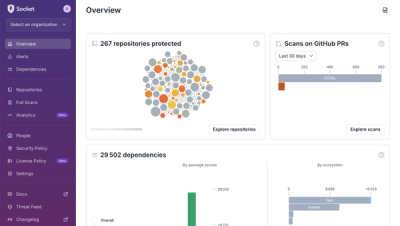
Research
wget to Wipeout: Malicious Go Modules Fetch Destructive Payload
Socket's research uncovers three dangerous Go modules that contain obfuscated disk-wiping malware, threatening complete data loss.
@altano/astro-html-to-image
Advanced tools
⚠️ WORK IN PROGRESS: This package requires changes1 in Astro before it will be useable. Sit tight!
This is an Astro middleware that allows you to easily render Astro components to images. This provides the foundation for Astro integrations like @altano/astro-opengraph-image.
In your existing Astro project:
# Using NPM
npm install @altano/astro-html-to-image
# Using Yarn
yarn add @altano/astro-html-to-image
# Using PNPM
pnpm add @altano/astro-html-to-image
Create a middleware.ts file2 if you haven't already. middleware.ts:
import { createHtmlToImageMiddleware } from "@altano/astro-html-to-image";
export const onRequest = createHtmlToImageMiddleware({ ... });
Create a component to convert to an image. It must have a .png.astro extension, e.g. image.png.astro:
<html><body>Hello!</body></html>
NOTE: Your Astro component must be HTML elements and styles supported by Satori, e.g. it can't be stateful or use calc() in css. The OG Image Playground is a great place to test your component before copying it into your Astro project.
middleware.ts:
import { createHtmlToImageMiddleware } from "@altano/astro-html-to-image";
export const onRequest = createHtmlToImageMiddleware({
runtime: "nodejs",
format: "png",
async getSvgOptions() {
const interRegularBuffer = await fetch(`https://files.terriblefish.com/fonts/Inter/v4/extras/otf/Inter-Regular.otf`).then((res) => res.arrayBuffer());
return {
width: 800,
height: 200,
fonts: [
{
name: "Inter",
data: interRegularBuffer,
weight: 400,
style: "normal",
},
],
};
},
});
image.png.astro:
---
/**
* This is not used during image generation. It is only here
* to make the fonts consistent between the generated image
* and how the component is rendered if the image generation
* middleware is disabled.
*/
import "@fontsource-variable/inter";
---
<html>
<body
style=`font-family: "Inter Variable";
background: white;
height: 100vh;
width: 100vw;
display: flex;
flex-direction: column;
align-items: center;
justify-content: center;`
>
<h1
style="font-weight: 800;
font-size: 5rem;
margin: 0;"
>
Kurt's Website!
</h1>
<p style="font-weight: 400;
font-size: 2rem;">
This is rendered as a PNG image.
</p>
</body>
</html>
See https://github.com/altano/npm-packages/tree/main/examples/astro-html-to-image for a slightly more involved example.
createHtmlToImageMiddleware requires the following options:
runtime: currently only "nodejs".format: Any output format that the @resvg/resvg-wasm library accepts, which is currently only "png".getSvgOptions: Options that the vercel/satori library accepts. At the very least, you must specify dimensions and one font to use.See the TypeScript type-hints and comments for more info.
middleware.ts:
import { createHtmlToImageMiddleware } from "@altano/astro-html-to-image";
export const onRequest = createHtmlToImageMiddleware({
format: "png",
async getSvgOptions() {
const interRegularBuffer = await fetch(`https://files.terriblefish.com/fonts/Inter/v4/extras/otf/Inter-Regular.otf`).then((res) => res.arrayBuffer());
const interBoldBuffer = await fetch(`https://files.terriblefish.com/fonts/Inter/v4/extras/otf/Inter-Regular.otf`).then((res) => res.arrayBuffer());
return {
width: 800,
height: 200,
fonts: [
{
name: "Inter",
data: interRegularBuffer,
weight: 400,
style: "normal",
},
{
name: "Inter",
data: interBoldBuffer,
weight: 800,
style: "normal",
},
],
};
},
});
See the React component example.
This library is a tiny wrapper around:
satori-html (html -> jsx)vercel/satori (jsx -> svg)The pipeline looks like this:
flowchart LR
S>component.astro] -->|astro| M[fa:fa-code html]
M -->|middleware| A[[astro-html-to-image]]
A -->|satori-html| B[fab:fa-react jsx]
B -->|vercel/satori| C[fa:fa-image svg]
C -->|resvg-wasm| D>"fa:fa-image png"]
FAQs
Render Astro components to images
We found that @altano/astro-html-to-image demonstrated a not healthy version release cadence and project activity because the last version was released a year ago. It has 1 open source maintainer collaborating on the project.
Did you know?

Socket for GitHub automatically highlights issues in each pull request and monitors the health of all your open source dependencies. Discover the contents of your packages and block harmful activity before you install or update your dependencies.

Research
Socket's research uncovers three dangerous Go modules that contain obfuscated disk-wiping malware, threatening complete data loss.

Research
Socket uncovers malicious packages on PyPI using Gmail's SMTP protocol for command and control (C2) to exfiltrate data and execute commands.

Product
We redesigned Socket's first logged-in page to display rich and insightful visualizations about your repositories protected against supply chain threats.